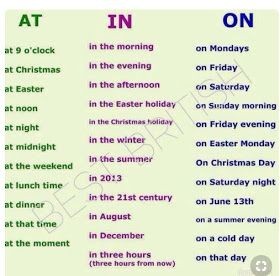English clauses always have a subject:
His father has just retired. Was a teacher. > He was a teacher.
I’m waiting for my wife.Is late. > Sheis late.
Look at the time!Is half past two.> It’s half past two.
I’m waiting for my wife.
Look at the time!
except for the imperative (see more)
Go away.
Play it again please.
Play it again please.
If we have no other subject we use thereor it.
there
We use there as a dummy subject with part of the verb be followed by a noun phrase. (see Clauses, sentences and phrases):
• to introduce a new topic:
There is a meeting this evening. It will start at seven.
There has been an accident. I hope no one is hurt.
There has been an accident. I hope no one is hurt.
• with numbers or quantities:
There was a lot of rain last night.
There must have been more than five hundred in the audience.
There must have been more than five hundred in the audience.
• to say where something is:
There used to be a playground at the end of the street.
There are fairies at the bottom of the garden.
I wonder if there will be anyone at home.
There are fairies at the bottom of the garden.
I wonder if there will be anyone at home.
• with an indefinite pronoun or expressions of quantity and the to-infinitive:
There is nothing to do in the village.
There was plenty to read in the apartment
There was nothing to watch on television.
There is a lot of work to do
If we want to show the subject of the to-infinitive we use for:
There was plenty to read in the apartment
There was nothing to watch on television.
There is a lot of work to do
If we want to show the subject of the to-infinitive we use for:
There is nothing for the children to do in the village.
There was plenty for us to read in the apartment
There was nothing for them to watchon television.
There is a lot of work for you to do.
There was plenty for us to read in the apartment
There was nothing for them to watchon television.
There is a lot of work for you to do.
• with an indefinite pronoun or expressions of quantity and an -ing verb:
There is someone waiting to see you.
There were a lot of people shoutingand waving.
There were a lot of people shoutingand waving.
We use a singular verb if the noun phrase is singular:
There is a meeting this evening. It will start at seven.
There was a lot of rain last night.
There is someone waiting to see you.
There was a lot of rain last night.
There is someone waiting to see you.
We use a plural verb if the noun phrase is plural:
There are more than twenty people waiting to see you.
There were some biscuits in the cupboard.
There were a lot of people shouting and waving.
There were some biscuits in the cupboard.
There were a lot of people shouting and waving.
It
We use it to talk about:
• times and dates:
It’s nearly one o’clock.
It’s my birthday.
It’s my birthday.
• weather:
It’s raining.
It’s a lovely day.
It was getting cold.
It’s a lovely day.
It was getting cold.
• to give an opinion about a place:
It’s very cold in here.
It will be nice when we get home.
It’s very comfortable in my new apartment.
It will be nice when we get home.
It’s very comfortable in my new apartment.
• to give an opinion followed by to-infinitive:
It’s nice to meet you.
It will be great to go on holiday.
It was interesting to meet your brother at last.
It will be great to go on holiday.
It was interesting to meet your brother at last.
• to give an opinion followed by an -ingverb:
It’s great living in Spain.
It’s awful driving in this heavy traffic.
It can be hard work looking afteryoung children.
It’s awful driving in this heavy traffic.
It can be hard work looking afteryoung children.
Using "it" to talk about people
We use it to talk about ourselves:
• on the telephone:
Hello. It’s George.
• when people cannot see us:
[Mary knocks on door] It’s me. It’s Mary.
We use it to talk about other people:
• when we point them out for the first time:
Look. It’s Sir Paul McCartney.
Who’s that? I think it’s John’s brother.
Who’s that? I think it’s John’s brother.
• when we cannot see them and we ask them for their name:
[telephone rings, we pick it up] Hello. Who is it?
[someone knocks on door. We say:] Who is it?
[someone knocks on door. We say:] Who is it?


































